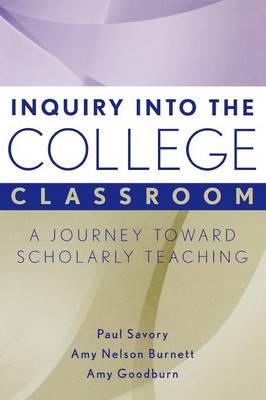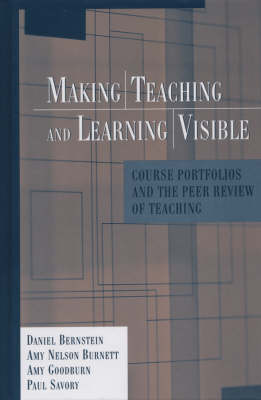JB - Anker
2 total works
Inquiry into the College Classroom
by Paul Savory, Amy Nelson Burnett, and Amy Goodburn
Published 26 September 2007
An essential companion for university faculty interested in conducting scholarly inquiry into their classroom teaching, this practical guide presents a formal model for making visible the careful, difficult, and intentional scholarly work entailed in exploring a teaching question. As a how-to guide, this is an invaluable resource for planning and conducting classroom research-formulating questions and hypotheses, defining a data collection methodology, collecting data, measuring the impact, and documenting the results.
Inquiry Into the College Classroom is filled with richly illustrative examples that highlight how university faculty from a range of academic disciplines have performed scholarly inquiries into their teaching and leads faculty on a journey that includes: * Developing a formal model for structuring the exploration of a classroom inquiry question* Providing a practical and useful guide for faculty interested in exploring teaching and learning challenges* Detailing faculty experiences in measuring specific changes in student learning or perspectives* Demonstrating how to document classroom inquiry in a form to be shared, used, and reviewed by other faculty* Sharing useful and practical suggestions for getting started with a classroom inquiry* Highlighting different models for disseminating classroom inquiry work* Linking classroom inquiry to larger conversations about the scholarship of teaching and learning
Inquiry Into the College Classroom is filled with richly illustrative examples that highlight how university faculty from a range of academic disciplines have performed scholarly inquiries into their teaching and leads faculty on a journey that includes: * Developing a formal model for structuring the exploration of a classroom inquiry question* Providing a practical and useful guide for faculty interested in exploring teaching and learning challenges* Detailing faculty experiences in measuring specific changes in student learning or perspectives* Demonstrating how to document classroom inquiry in a form to be shared, used, and reviewed by other faculty* Sharing useful and practical suggestions for getting started with a classroom inquiry* Highlighting different models for disseminating classroom inquiry work* Linking classroom inquiry to larger conversations about the scholarship of teaching and learning
Making Teaching and Learning Visible
by Daniel Bernstein, Amy Nelson Burnett, Amy Goodburn, and Paul Savory
Published 24 July 2007
With higher education's refocus over the last three decades on bringing greater recognition and reward to good teaching, the idea of peer review has gained popularity. One tool for documenting and reflecting on the quality of teaching and student learning is a course portfolio. A course portfolio captures and makes visible the careful, difficult, and intentional scholarly work of planning and teaching a course. Illustrated through examples of course portfolios created during a four-year project on peer review of teaching, this book demonstrates how faculty can integrate well-designed peer review into their daily professional lives, thus improving their teaching by incorporating a means for assessment and collaboration and revealing the student learning that happens with effective teaching within an institutional reward systems. This book offers a model of peer review intended to help faculty document, assess, reflect on, and improve teaching and student learning through the use of a course portfolio.
It features a rich collection of materials-including four dozen exhibits to help assemble a portfolio, reviewers' comments, and reflections drawn from more than 200 professors and portfolio authors in various disciplines and institutions-that faculty can use to develop their course portfolios to be used in their peer review of teaching.
It features a rich collection of materials-including four dozen exhibits to help assemble a portfolio, reviewers' comments, and reflections drawn from more than 200 professors and portfolio authors in various disciplines and institutions-that faculty can use to develop their course portfolios to be used in their peer review of teaching.

